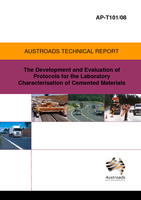Pavement

The Development and Evaluation of Protocols for the Laboratory Characterisation of Cemented Materials
- Publication no: AP-T101-08
- ISBN: 978-1-921329-74-6
- Published: 14 August 2008
- PDF (free) Download
The study involved a laboratory assessment of two cemented materials to assess their strength, modulus and fatigue properties. The cemented materials consisted of a hornfels crushed rock and a quartzite siltstone bound with general purpose cement at 3% and 4% addition rate by mass respectively. The laboratory testing involved unconfined compressive strength, indirect tensile testing and flexural beam testing. Samples were prepared in the laboratory and from field placed cemented material and cured for a variety of periods from 7 days to over 500 days prior to testing. The study showed that the flexural beam test was a suitable means for assessment of the modulus and fatigue of cemented materials and that load damage exponents for the cemented materials varied between about 6 and 8. The laboratory results are to be compared with full scale accelerated pavement test results as the next stage in the overall research project.
- AP-T101/08 THE DEVELOPMENT AND EVALUATION OF PROTOCOLS FOR THE LABORATORY CHARACTERISATION OF CEMENTED MATERIALS
- 1. INTRODUCTION
- 1.1. Project Objectives for Cemented Materials Research
- 1.2. Aims of the Laboratory Study
- 2. MATERIAL PROPERTIES
- 3. LABORATORY TEST METHODS
- 3.1. Unconfined Compressive Strength (UCS)
- 3.2. Indirect Tensile (IDT) Test
- 3.3. Flexural Beam Test
- 4. TEST SAMPLES
- 4.1. Field Samples
- 4.2. Laboratory Mixed and Compacted Samples
- 4.3. Field Mixed, Laboratory Compacted Samples
- 5. RESULTS
- 5.1. Strength
- 5.2. Modulus (IDT and Flexural Beam)
- 5.3. Fatigue (IDT and Flexural Beam)
- 6. DISCUSSION
- REFERENCES
- Table B1: Width and radius of curvature of loading block (millimetres)
- Table B2: Specimen dimensions (mm)
- Table C1: Test machine capability - Peak load against material stiffness range
- Table C2: Width and radius of curvature of loading block (millimetres)
- Table C3: Specimen dimensions millimetres
Related publications
Latest Pavement News
